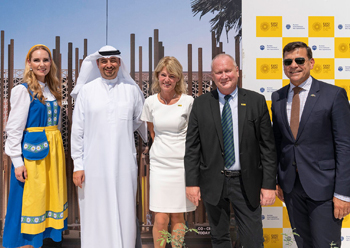Swedish ‘Forest’ to come up in Dubai
01 November 2019
The construction of Sweden’s pavilion at the Expo 2020 world exhibition officially began last month to the tunes of a haunting melody inspired by traditional folk music and ancient Swedish herd calling.
Instead of the traditional ground-breaking with hard hats and shovels, the Swedish Minister for Foreign Trade Anna Hallberg planted trees – Ghaf trees to be specific. Native to the Gulf region, Ghaf trees are a symbol of the Year of Tolerance in the UAE this year – they survive in arid conditions by sinking their roots deep into the soil.
Hallberg said: “As a Swede, I have a strong connection to the forest and the environment, so I am very pleased to be doing a ground planting here at the Swedish pavilion, instead of a groundbreaking.
“While Expo 2020 Dubai will welcome 25 million visitors from across the world, we expect at least one million visitors at the Swedish pavilion.”
“Expo 2020 Dubai is a unique opportunity to showcase Swedish industry and our power to innovate to the wider regions of the Middle East, Asia and Africa. Sweden is a small, export-dependent country, so we see this as a great arena to attract new business opportunities for Swedish companies. This will also help us reach regions and countries where we are perhaps not so active in at the moment,” said the minister of foreign trade.
The Swedish pavilion, called the Forest, will be located within the Sustainability district of Expo 2020 Dubai and will depict a forest: a fusion of dense Nordic woodland and Arabic geometric design, bringing together two cultures.
Mattias Hansson, programme director for the Swedish Pavilion at Expo 2020, told RASHI SEN of TTN, our sister publication: “There will be around 80 ground-breaking ceremonies at Expo 2020 Dubai but we will likely be the only ones doing a ground planting. This is also in line with our main theme here – sustainability. Through the pavilion, we will share our thousands of years of experience in how to harvest and grow trees, with countries that probably do not have this specialist knowhow. In the process, we will also help plant more trees.”
Sweden is likely to be the only country pavilion in Expo 2020 Dubai with an actual forest (or in the very least, a large selection of trees on site) but he said it doesn’t want to keep the idea exclusive at all. “On the contrary, I hope everyone does what we are doing, this way there will be more trees,” he said with a smile.
The Swedish pavilion will focus on ‘co-creation for innovation’ and the spirit of co-creation begins in the design stage itself with a team of three agencies from three countries, Alessandro Ripellino Architects, Studio Adrien Gardère and Luigi Pardo Architetti, involved in the pavilion.
Hansson added: “We think that the best innovations come out of co-creation. If you do things together, the results will always come out better than if you do things alone. We are a very anti-hierarchical society, so we will be showing the world a different way of doing things.”
The Swedish pavilion, with a gross built-up area of 2,370.2 sq m, will be built in wood to the maximum extent possible (using alternative materials instead of concrete and steel may save 1,000 tonnes of carbon dioxide emissions). The public areas including the exhibition and café will be at the ground level, while offices and conference rooms will be raised aloft – like tree houses – forming a roof over parts of the pavilion.
The Swedish pavilion will consist of five themes: next generation’s travel and transport, smart cities, circular and bio-based economy, life science, and a connected industry and new materials. The Forest will promote Sweden as a world-class partner and location for trade, investment and tourism.
Carl Mörner, Sweden’s deputy ambassador to the UAE, said:“Our main exports to the UAE are telecommunication equipment, wood materials, steel and pharmaceuticals and medical equipment. Export value has varied between 5 to 8 billion Swedish kronor ($509.2 to 814.8 million) over the last four years.”
- Cynosure of the world!
- Malaysia kicks off work on ‘Rainforest Canopy’
- Pavilion design unveiled by Enoc
- Making trade flow – theme for DP World
- Swedish ‘Forest’ to come up in Dubai
- World Architecture Day commemorated



